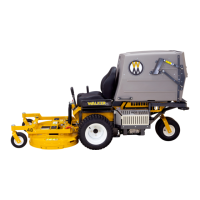Operating Instructions
50
● Check the blower wheel for bent blades and
excessive clearance between the blade tip and the
blower housing. A clearance greater than
1/8 in. (3 mm) will cause a signicant loss of blower
performance.
● Check the blower discharge chute into the grass
catcher for smoothness and freedom from ob-
struction.
● Check the elbow inside the grass catcher for a
buildup of material in the radius of the elbow. In
certain conditions (damp/dirty grass) a considerable
“clump” of material can accumulate at this point,
greatly restricting material and airow.
● Check that the openings in the removable air
exhaust screen in the grass catcher are not
plugged. If the screen is clogged, refer to Cleaning
the GHS Exhaust Screen in this section.
NOTE: An optional exhaust screen with larger
holes (3/4") is available for use when mowing in wet
grass; the screen provides less airow restriction
and more clog resistance (use standard screen in
dry conditions to avoid excessive material blowing
out of the catcher).
Remember, anything that restricts airow or mate-
rial ow along the entire path from the mower deck
to the grass catcher can cause clogging.
Using the Tilt-Up Deck
Refer to CLEANING of Grass Buildup in Mower
Deck Housing in Maintenance Instructions.
Using the GHS Catcher
Powerl
®
The GHS catcher has an oscillating grass delivery
spout (POWERFIL
®
) which is designed to spread
grass clippings throughout the interior of the grass
catcher (even when mowing wet, heavy grass). The
oscillating action may be checked by turning the
ignition switch to the ON (RUN) position and
moving the blade clutch to the ENGAGED posi-
tion. The spout should oscillate approximately 35
cycles per minute.
NOTE: If the grass spout fails to oscillate, the clutch
switch should be checked for function (the switch
closure is adjustable).
“Full” Signal Horn
The GHS catcher has a “full” signal horn to alert
the operator to dump the catcher when it is full (to
prevent overlling and clogging). The “full” signal
horn is activated by a vane switch (Grass-Pak
®
switch) mounted on the grass delivery spout. Oscil-
lating action of the spout triggers the vane switch as
grass begins to ll in around the spout when the
catcher is almost full.
The “full” signal function may be checked by turning
the ignition switch to ON (RUN), engaging the blade
clutch (engine not running), opening the catcher
back door, and triggering the Grass-Pak
®
vane by
hand as it oscillates. The horn should sound as the
switch is moved in one direction.
WARNING
DO NOT test the Powerl
®
oscillation or
Grass-Pak
®
switch with the engine run-
ning. Projectiles may be thrown out of the
grass delivery spout, and COULD cause
serious injury.
The “full” signal horn is designed to operate (sound)
when the grass catcher is almost full. The timing
of the signal is adjustable by changing the position
of the vane on the Grass-Pak
®
switch. If the signal
is coming on too soon (catcher not completely full)
or too late (grass clogging in catcher spout and
deliv ery chute), refer to ADJUSTMENTS for GHS
“Full” Signal Horn Adjustment
in
Maintenance In-
structions
.
NOTE: The horn signal should be adjusted to
sound BEFORE the catcher is completely full to
give the operator time to react and stop mowing. An
indication the horn signal is coming on too late (de-
layed too much) is if grass clippings are falling out of
the grass catcher delivery chute when the catcher is
dumped.

